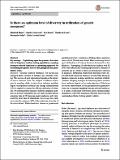Por favor, use este identificador para citar o enlazar a este item:
http://hdl.handle.net/10261/169656COMPARTIR / EXPORTAR:
 SHARE SHARE
 CORE
BASE CORE
BASE
|
|
| Visualizar otros formatos: MARC | Dublin Core | RDF | ORE | MODS | METS | DIDL | DATACITE | |

| Campo DC | Valor | Lengua/Idioma |
|---|---|---|
| dc.contributor.author | Mayer, Manfred | es_ES |
| dc.contributor.author | Unterseer, Sandra | es_ES |
| dc.contributor.author | Bauer, Eva | es_ES |
| dc.contributor.author | Leon, Natalia de | es_ES |
| dc.contributor.author | Ordás López, Bernardo | es_ES |
| dc.contributor.author | Schön, Chris-Carolin | es_ES |
| dc.date.accessioned | 2018-09-13T08:54:55Z | - |
| dc.date.available | 2018-09-13T08:54:55Z | - |
| dc.date.issued | 2017-08-05 | - |
| dc.identifier.citation | Theoretical and Applied Genetics 130 (11): 2283–2295 (2017) | es_ES |
| dc.identifier.issn | 0040-5752 | - |
| dc.identifier.uri | http://hdl.handle.net/10261/169656 | - |
| dc.description | 13 páginas y 6 figuras. | es_ES |
| dc.description.abstract | Genome-enabled strategies for harnessing untapped allelic variation of landraces are currently evolving. The success of such approaches depends on the choice of source material. Thus, the analysis of different strategies for sampling allelic variation from landraces and their impact on population diversity and linkage disequilibrium (LD) is required to ensure the efficient utilization of diversity. We investigated the impact of different sampling strategies on diversity parameters and LD based on high-density genotypic data of 35 European maize landraces each represented by more than 20 individuals. On average, five landraces already captured ~95% of the molecular diversity of the entire dataset. Within landraces, absence of pronounced population structure, consistency of linkage phases and moderate to low LD levels were found. When combining data of up to 10 landraces, LD decay distances decreased to a few kilobases. Genotyping 24 individuals per landrace with 5k SNPs was sufficient for obtaining representative estimates of diversity and LD levels to allow an informed pre-selection of landraces. Integrating results from European with Central and South American landraces revealed that European landraces represent a unique and diverse spectrum of allelic variation. Sampling strategies for harnessing allelic variation from landraces depend on the study objectives. If the focus lies on the improvement of elite germplasm for quantitative traits, we recommend sampling from pre-selected landraces, as it yields a wide range of diversity, allows optimal marker imputation, control for population structure and avoids the confounding effects of strong adaptive alleles. | es_ES |
| dc.description.sponsorship | This study was funded by the Federal Ministry of Education and Research (BMBF, Germany) within the AgroClustEr Synbreed—Synergistic plant and animal breeding (Grant 0315528), by the Bavarian State Ministry of the Environment and Consumer Protection within the project network BayKlimaFit (Project TGC01GCUFuE69741 “Improving cold tolerance in maize”), by the Spanish Ministry of Economy and Competitiveness (Project RF2011-00022-C02-01 “Regeneration and rationalization of the maize landraces from the Iberian Peninsula”) and by the KWS SAAT SE under a Ph.D. fellowship for Manfred Mayer. Bernardo Ordas acknowledges a grant from the program “Ramón y Cajal” of the Spanish Ministry of Economy and Competitiveness. | es_ES |
| dc.language.iso | eng | es_ES |
| dc.publisher | Springer Nature | es_ES |
| dc.relation.isversionof | Publisher's version | es_ES |
| dc.rights | openAccess | es_ES |
| dc.title | Is there an optimum level of diversity in utilization of genetic resources? | es_ES |
| dc.type | artículo | es_ES |
| dc.identifier.doi | 10.1007/s00122-017-2959-4 | - |
| dc.description.peerreviewed | Peer reviewed | es_ES |
| dc.relation.publisherversion | http://dx.doi.org/10.1007/s00122-017-2959-4 | es_ES |
| dc.identifier.e-issn | 1432-2242 | - |
| dc.contributor.funder | Federal Ministry of Education and Research (Germany) | es_ES |
| dc.contributor.funder | Bavarian Ministry of the Environment and Consumer Protection | es_ES |
| dc.contributor.funder | Ministerio de Economía y Competitividad (España) | es_ES |
| dc.contributor.funder | KWS SAAT SE | es_ES |
| dc.relation.csic | Sí | es_ES |
| oprm.item.hasRevision | no ko 0 false | * |
| dc.identifier.funder | http://dx.doi.org/10.13039/501100003329 | es_ES |
| dc.identifier.funder | http://dx.doi.org/10.13039/501100010219 | es_ES |
| dc.identifier.funder | http://dx.doi.org/10.13039/501100002347 | es_ES |
| dc.identifier.pmid | 28780586 | - |
| dc.type.coar | http://purl.org/coar/resource_type/c_6501 | es_ES |
| item.fulltext | With Fulltext | - |
| item.languageiso639-1 | en | - |
| item.openairecristype | http://purl.org/coar/resource_type/c_18cf | - |
| item.openairetype | artículo | - |
| item.cerifentitytype | Publications | - |
| item.grantfulltext | open | - |
| Aparece en las colecciones: | (MBG) Artículos | |
Ficheros en este ítem:
| Fichero | Descripción | Tamaño | Formato | |
|---|---|---|---|---|
| Mayer_Is_there...pdf | Artículo principal | 2,72 MB | Adobe PDF |  Visualizar/Abrir |
CORE Recommender
PubMed Central
Citations
15
checked on 21-mar-2024
SCOPUSTM
Citations
22
checked on 23-abr-2024
WEB OF SCIENCETM
Citations
20
checked on 25-feb-2024
Page view(s)
297
checked on 24-abr-2024
Download(s)
194
checked on 24-abr-2024
Google ScholarTM
Check
Altmetric
Altmetric
Artículos relacionados:
NOTA: Los ítems de Digital.CSIC están protegidos por copyright, con todos los derechos reservados, a menos que se indique lo contrario.
